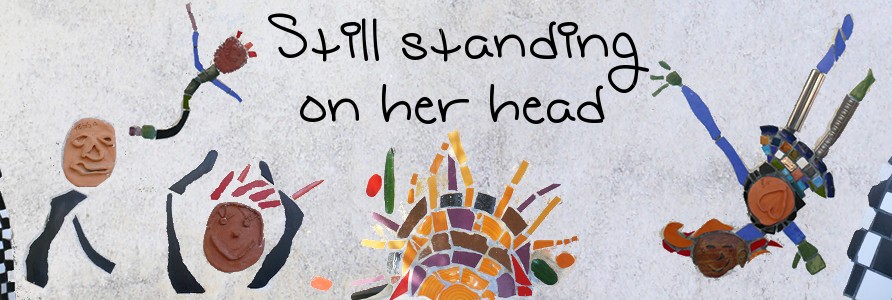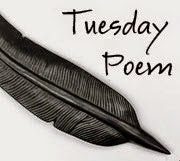This week's optional prompt at Poetry Thursday was to read some poetry out loud. On the same day that I read the prompt, I found two poems by Seamus Heaney on the Poetry Daily website that just itched to be read aloud. The first of these really caught hold of my imagination. What is it about Heaney's work that entices me so much? He uses plain words, no metaphors or similes, just straightforward descriptions. He writes in form which not many poets do these days. These poems are sonnets and they conform pretty well to the traditional sonnet metre and rhyme scheme. And yet they sound very natural. Heaney doesn't resort to twisting the grammar, or using filler words like "oh", or abbreviations like "o'er" to make his words fit. The rhythms make them wonderful poems to read aloud. There is something about "red beef, white string/ Brown paper ripped straight off for parcelling/ along the counter edge. Rib roast and shin/Plonked down, wrapped up, and bow-tied neat and clean" that I want to roll around my tongue and repeat over and over.
There is another use for reading poetry aloud and that is for editing. I find when I write that I sometimes am at a loss as to how to edit my poems. I know that there is something not quite right and yet I don't know what to do about it. I find that if I read my own poems out loud, five or six times, and then go and vacuum the house or dig the garden, something will suddenly come to me that will solve a problem. I have been doing some of that this week, as I sort my poems and make submissions to various magazines in the hope that someone will give some of my "babies" a home.
It's time today to resume my series on the influence of poetry in my life. Today, my high school years. I had encountered poetry in primary school but not in any systematic way. At high school we were taught poetry more regularly - first forms and metre - the sonnet, the ballad - and later specific poets. I encountered Shakespeare, Donne, Wordsworth, Tennyson and later Gerard Manley Hopkins and T.S.Eliot. We even studied a modern New Zealand poet - Louis Johnson - who actually came and spoke to us - the first time I had encountered a living, breathing poet (and discovered he was a very ordinary looking man). I began to encounter a few poems that didn't rhyme, or where the rhyme was a little looser. There was free verse,as in Shakespeare's plays, of course, but that is still quite highly structured - no rhymes, but the rhythm is quite strict. The Eliot was much more variable in line length - though it still has a good deal of rhyme - still, I fell in love with "The Love Song of J. Alfred Prufrock" and others. One of my English teachers apparently told my mother "Catherine has a real feel for modern poetry". I enjoyed modern poetry in French classes too, particularly Jacques Prevert. Still, in high school something else happened which changed my path for many years - I discovered science. I changed my career ambitions from "writer" to "scientist". I believe now that the common thread between all my enthusiasms - science, poetry, quilting, and even genealogy - is a love of pattern, of seeing how things fit together and how they repeat.
I wrote only a little poetry in high school. I do remember a line from a poem in which I tried rather clumsily to imitate the style of Gerard Manley Hopkins. It was interesting to see that Seamus Heaney, in one of several articles linked on the Poetry Daily news page, referred to Hopkins as being an early influence. I was a bit misguided at the time. I believed that Hopkins made words up. Actually I have since found that he revived archaic words, and it was the influence of this strong Anglo-Saxon language that Heaney was referring to. My poem was about a moth and the line I recall is "wind-whiffled, wing-wafted through the dark night". I'm still trying to write about moths and I haven't done it quite to my satisfaction yet!
The poem that I am going to share in full today is by Hopkins, and it is also a good one for reading aloud:
Inversnaid
This darksome burn, horseback brown,
His rollrock highroad roaring down,
In coop and in comb the fleece of his foam
Flutes and low to the lake falls home.
A windpuff-bonnet of fawn-froth
Turns and twindles over the broth
Of a pool so pitchblack, fell-frowning,
It rounds and rounds Despair to drowning.
Degged with dew, dappled with dew
Are the groins of the braes that the brook treads through,
Wiry heathpacks, flitches of fern.
And the beadbonny ash that sits over the burn.
What would the world be, once bereft
Of wet and of wildness? Let them be left,
O let them be left, wildness and wet;
Long live the weeds and the wilderness yet.
- Gerard Manley Hopkins, 1844-1889
More Poetry Thursday participants here
Thursday, June 01, 2006
Subscribe to:
Post Comments (Atom)



5 comments:
the alliteration brutally drags me through that poem!
Yes, I came across those two poems at Poetry Dailey, too. And to bring Hopkins in, as well, with this week's prompt is so very fitting. Your commentary, too, is rich and reflective.
This had WOW effect on me..specially the last para..
"What would the world be, once bereft
Of wet and of wildness? Let them be left,
O let them be left, wildness and wet;
Long live the weeds and the wilderness yet."
Thanks for sharing..
Oh, that poem just begs to be read aloud, doesn't it!
And I'm with you on the fascination with pattern and rhythm. That theme runs through many aspects of my life as well.
Wonderful poem and form. Thank you for introducing Heaney's work to me.
Post a Comment